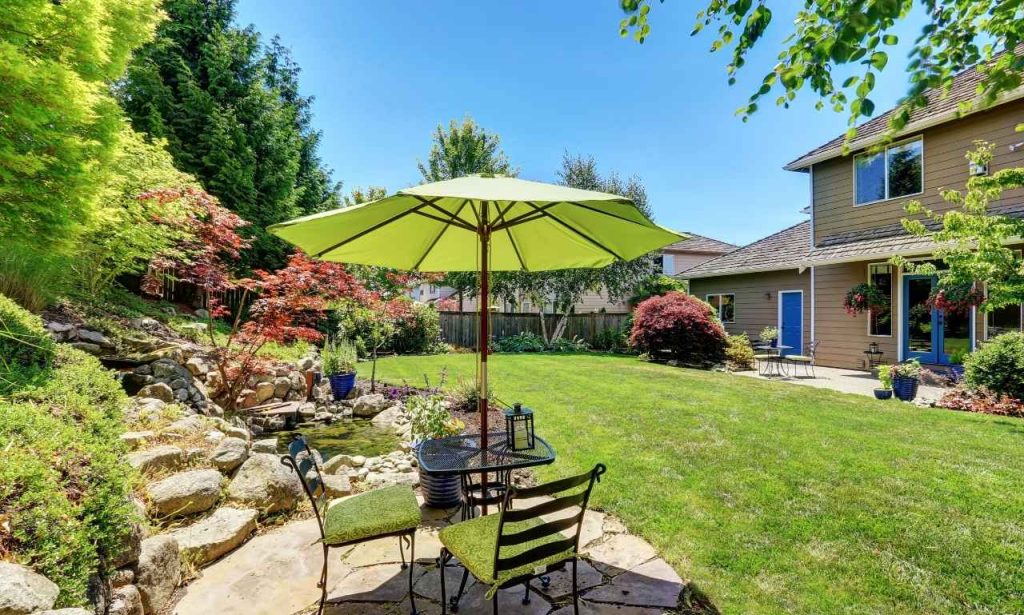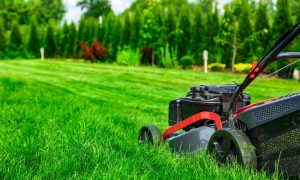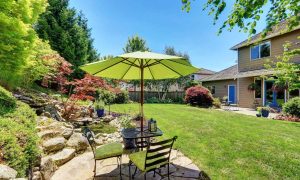Behind every house lies an opportunity waiting to be discovered. Your backyard isn’t just extra square footage. It’s where summer memories take shape. My own backyard sat neglected for years after we moved in. We focused on fixing up the inside of our fixer-upper first. The kids played on a patchy lawn surrounded by overgrown bushes. Then, last spring, we finally tackled the outdoor space. The transformation changed how our family spends time together. Your backyard holds the same potential. This guide shows you how to create your dream backyard.
What Makes a Great Backyard?

Great backyards balance beauty with real-life usability. My cousin spent a fortune copying a design from a magazine. Now his yard sits empty most days. Nobody feels comfortable using it. The best yards invite you outside without shouting “don’t touch!” They solve problems instead of creating more work. Kids need space to run and play without breaking anything precious. Adults want comfortable spots to relax with friends over drinks. Everyone appreciates shade on hot days and sun on cool ones.
Your yard should match your actual lifestyle, not an imagined perfect one. If you hate yard work, don’t plant high-maintenance gardens. If you rarely entertain large groups, skip the massive patio set. My neighbor built a huge outdoor kitchen that he’s used exactly twice. Start with how you honestly live, not how you think you should. The perfect backyard feels lived-in rather than museum-perfect. It grows and changes alongside your family and interests.
Personal touches make a yard special, turning it from generic to meaningful. My grandmother gathered stones from family trips for her garden borders. Each rock held a story about our adventures together. Your yard might include a hammock for afternoon naps or a fire pit. Perhaps you need raised beds for growing tomatoes or a shady reading nook. These personal elements turn ordinary space into your special place.
How Do I Decide What to Do With My Backyard?
Start by watching your yard through different seasons before making big changes. Notice where water pools after rain and which areas get morning or afternoon sun. These natural patterns should guide your decisions, not fight against them. My sister planted a vegetable garden in the shadiest spot of her yard. Nothing grew, despite her constant attention. Working with nature always beats working against it.
Ask what you actually want from your outdoor space. Make honest lists about your family’s real habits. Do you host weekly cookouts or prefer quiet mornings with coffee? Are there kids or pets who need safe places to play? Write down activities you’d enjoy doing outdoors if your space supported them. This approach prevents creating pretty but unused features. Your backyard should enhance daily life, not just look good on Instagram.
Set a budget before falling in love with specific ideas. Backyard projects have a sneaky way of expanding beyond initial plans. Remember to include ongoing maintenance costs, too. My brother installed a fancy water feature without considering electricity and cleaning supplies. It now sits unplugged because upkeep costs surprised him. Research prices for materials and professional help where needed. Prioritize elements that deliver the most enjoyment for your specific situation.
Consider your long-term plans for the property. Will your needs change significantly in the next five years? Creating flexible spaces allows your yard to evolve with changing family dynamics. The huge play structure might need replacing with a fire pit someday. Good planning prevents expensive do-overs down the road. Leave room for your backyard to grow alongside your life.
How Do I Turn My Backyard Into an Oasis?
Creating a true backyard retreat starts with clearing out the junk. Broken toys, rusty grills, and forgotten projects must go. This clean-up phase reveals what you’re actually working with. My friends couldn’t see past the pile of old bricks and lumber in their yard. Once cleared, they discovered a perfect spot for their patio. Start with a blank canvas before adding new elements to your outdoor space.
Include features that engage all senses for a fully immersive experience. Wind chimes add a gentle sound even on still days. Fragrant plants like roses or herbs bring pleasant scents to outdoor sitting areas. Soft lighting transforms ordinary spaces into magical evening retreats. Comfortable furniture invites you to linger rather than just pass through. These thoughtful touches create a genuine escape right outside your door.
Privacy turns a regular backyard into a true sanctuary. Nobody relaxes fully while feeling watched by neighbors. Tall grasses provide quick screening without permanent structures. Vine-covered trellises offer beautiful solutions to overlooked areas. My favorite yard uses staggered fence panels, creating secluded spots throughout the space. These privacy solutions let you truly unwind in your outdoor retreat.
Add personal elements that make your backyard uniquely yours. Old windows repurposed as garden art add character nobody else has. Family treasures displayed thoughtfully create meaningful moments throughout the yard. My uncle’s gardening shoes turned planters mark his passing while celebrating his passion. These personal touches transform generic outdoor space into your special place. The most memorable backyards tell stories about the people who created them.
Designing Your Backyard Garden Landscape and Outdoor Living Space
Create specific zones within your backyard
Dividing your yard into distinct areas maximizes functionality even in small spaces. Each zone should serve a specific purpose within your overall plan. The cooking area keeps smoke and heat away from relaxation spots. Dining spaces place food and conversation together naturally. Play areas contain toys and activities in designated spots. My tiny yard includes a morning coffee corner catching early sun. These purposeful zones prevent the feeling that everything’s jumbled together haphazardly.
Zone creation doesn’t require expensive walls or permanent structures. Simple changes in ground material naturally define different spaces. Gravel, wood chips, and grass each suggest different activities to visitors. Tall planters create flexible room dividers that change with the seasons. Outdoor rugs instantly establish conversation areas on existing patios. These easy techniques create distinct spaces without major construction headaches.
Unify different zones with thoughtful design and color palettes
Connect separate areas using repeated elements throughout your yard for visual flow. Similar materials, colors, or plants link zones into one coherent space. My friend uses the same rusty red color in cushions, pots, and artwork. This simple trick makes her multi-zone yard feel intentionally designed. Consider how people naturally move between areas when planning layouts. Clear pathways prevent trampled plants and muddy shortcuts across the lawn.
Color schemes play a crucial role in tying everything together visually. Choose three to five colors that work well with your house’s exterior. Repeat these colors in plants, furniture, and decorative elements throughout your yard. This consistent palette creates harmony between distinct functional areas. The neighbors on our street planted similar flowering trees along their property lines. This thoughtful connection makes separate yards flow together beautifully.
Choose the right plants

Plant selection dramatically impacts your yard’s success and maintenance requirements. Native plants thrive with minimal care once established in your local conditions. They’ve already adapted to your region’s weather and soil types. Visit local nurseries for specific recommendations before buying anything. The garden center near us specializes in drought-tolerant plants for our area. Their suggestions survived last summer’s heat wave while others struggled.
When designing your garden spaces, account for each plant’s mature size. That cute two-foot shrub might reach eight feet tall in a few years. Allow adequate spacing between plants for proper air circulation and growth. Crowded plants compete for resources and often develop disease problems. My cousin’s garden looked sparse initially but filled in beautifully by year three. Patience rewards gardeners with healthier plants and fewer maintenance headaches.
Mix plants with different seasonal highlights for year-round interest in your yard. Spring bulbs give way to summer flowers, followed by fall color. Winter reveals interesting bark patterns and evergreen structure. My neighbor’s garden features something worth seeing every month of the year. This thoughtful planning ensures your outdoor space remains attractive throughout all seasons.
Don’t overcrowd your yard
Restraining yourself to create more successful yard designs rather than cramming in too many features. Leave adequate open space for eyes to rest and for people to move freely. Every backyard needs breathing room regardless of its overall size. The most common mistake involves adding too many different elements. This cluttered approach creates visual chaos rather than a peaceful retreat. Select fewer, better-quality items instead of numerous competing features.
Consider both the physical and visual impact of elements in your yard design. Large features like boulders or water fixtures need balancing open space around them. Too many focal points create competition for attention within the landscape. My sister removed half her garden decorations and immediately improved her yard. The remaining pieces finally got the attention they deserved. This “less is more” approach creates sophisticated, restful outdoor spaces.
Outfit your deck with planters
Container gardens bring plants closer to seating areas while adding flexibility to decks. They create an instant impact where traditional gardens wouldn’t work. Fewer large containers make stronger statements than many small ones. Group pots of varying heights for more interesting arrangements. My deck features three oversized planters instead of a dozen tiny ones. This approach creates a greater visual impact while reducing daily watering needs.
Choose containers that complement your home’s style and outdoor furniture. Material affects both appearance and plant health in containers. Terracotta dries quickly, while plastic retains moisture longer. Consider how materials will weather in your climate before purchasing. Metal pots may overheat duringthe summer months in sunny locations. These practical considerations ensure both beauty and function in your container garden.
Experience the benefits of the Free Landscape Design Software!
Free design programs help visualize possibilities before spending time and money. These tools allow experimentation with different layouts and plant combinations. You can view potential projects from multiple angles and perspectives. Thanks to design software, my buddy avoided a costly mistake. His planned patio would have blocked drainage and caused flooding issues. The program revealed problems that weren’t obvious from simple sketches.
Most free landscape software includes plant libraries with growth information. This feature helps prevent common spacing mistakes in garden planning. You’ll see how plants look at maturity rather than just installation size. Some programs even show seasonal changes throughout the year. This comprehensive view prevents disappointing gaps in your garden’s appearance. The visualization helps create more successful garden plans from the beginning.
What is the best landscape design software?
Several excellent free options exist for homeowners planning backyard projects. Each program offers different features and learning curves. Many landscape pros recommend SketchUp for its user-friendly interface. The free version provides adequate tools for most homeowner projects. Online reviews suggest starting with simpler programs before tackling complex software. This approach builds confidence while learning basic design principles.
Consider your specific needs when choosing landscape design software. Some programs excel at plant selection and spacing visualization, while others offer better hardscape design tools for patios and structures. Many homeowners find that using several free resources works best. My neighbor used one program for the overall layout and another for plant selection. This flexible approach leverages the strengths of multiple design tools.
How much does it cost to have a landscape design?

Professional landscape design services vary widely in price depending on several factors. Basic design packages for average yards typically start around $2,000-3,000. Complex properties or extensive projects command higher fees for design work. Some designers charge hourly while others price by project scope. My cousin paid $2,500 for a comprehensive design plan last spring. This investment saved thousands in potential mistakes during implementation.
Many landscape companies offer design services with installation package purchases. This approach often reduces upfront design costs for homeowners. The company recoups design expenses through the installation work that follows. Ask whether the design fee applies toward installation costs later. This arrangement provided my friend with professional guidance at a reduced overall expense.
Consider the value rather than just the cost of professional landscape design. Good designers prevent expensive mistakes and wasted resources in your yard. They anticipate problems that most homeowners wouldn’t recognize until too late. My brother tried saving money by skipping professional design help. He ended up spending twice as much fixing drainage issues afterward. The right designer saves more than their fee through efficient planning.
Conclusion
Creating your dream backyard takes thoughtful planning and honest self-reflection. The process starts with understanding what you truly want from your outdoor space. Small changes often bring bigger satisfaction than expensive overhauls. Begin with cleaning and organizing before making major purchases. This approach reveals your yard’s true potential without wasting resources.
Remember that successful backyards evolve over time rather than appearing overnight. The most beautiful outdoor spaces develop through seasons of care and adjustment. Your garden will teach you what works in your specific conditions. Be willing to adapt your vision based on real-world results. This flexible mindset leads to more successful and satisfying outdoor spaces.
Your dream backyard ultimately reflects your unique preferences and lifestyle needs. Don’t feel pressured to follow every trend or neighbor’s example. The best backyards serve their owners’ actual lives rather than magazine ideals. My own yard prioritizes low maintenance over showiness. This choice gives me more time to enjoy the space rather than constantly working on it. Your perfect backyard awaits when you align design with your authentic needs.
Also Read: The Benefits of a Biodiverse Lawn
FAQs
Most basic backyard transformations require one season for installation and another for plants to establish.
Begin with thorough cleanup, then add defined seating areas and container gardens for immediate impact.
Choose native plants, install efficient irrigation, use mulch liberally, and create less lawn area.
Outdoor kitchens, quality patios, professional landscaping, and privacy features typically offer the best return.
Strategic tree placement, tall grasses, trellises with vines, or decorative screens provide natural privacy solutions.



